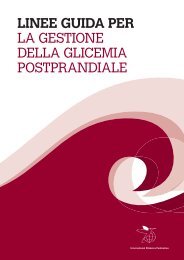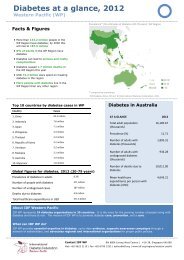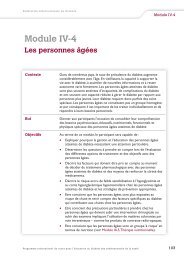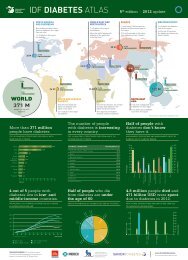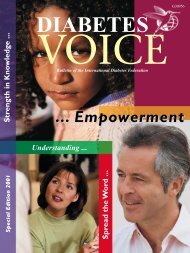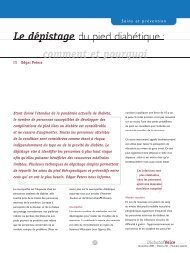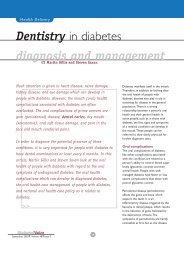The psycho-social impact of diabetes foot damage
The psycho-social impact of diabetes foot damage
The psycho-social impact of diabetes foot damage
Create successful ePaper yourself
Turn your PDF publications into a flip-book with our unique Google optimized e-Paper software.
<strong>The</strong> <strong>psycho</strong>-<strong>social</strong> <strong>impact</strong><br />
T h e g l o b a l i m p a c t<br />
<strong>of</strong> <strong>diabetes</strong> <strong>foot</strong> <strong>damage</strong><br />
y Loretta Vileikyte<br />
Over half <strong>of</strong> all lower-extremity amputations are related to<br />
<strong>diabetes</strong>. Indeed, <strong>foot</strong> ulceration is an increasing problem<br />
worldwide and there is little evidence <strong>of</strong> a reduction in the<br />
numbers <strong>of</strong> <strong>foot</strong> ulcers and amputations in people with<br />
<strong>diabetes</strong>. In this article, Loretta Vileikyte argues that in<br />
order to alleviate the suffering <strong>of</strong> people affected by this<br />
common and disabling complication <strong>of</strong> <strong>diabetes</strong>, we must<br />
improve our understanding <strong>of</strong> the <strong>psycho</strong>-<strong>social</strong> factors<br />
involved in the development <strong>of</strong> <strong>diabetes</strong> <strong>foot</strong> ulcers; and <strong>of</strong><br />
the ways in which people’s day-to-day functioning and their<br />
quality <strong>of</strong> life are influenced by <strong>foot</strong> <strong>damage</strong>.<br />
>><br />
One <strong>of</strong> the characteristic features <strong>of</strong><br />
<strong>diabetes</strong> <strong>foot</strong> ulcers, distinguishing<br />
them from other chronic wounds,<br />
is that they are usually painless<br />
– the result <strong>of</strong> <strong>diabetes</strong>-provoked<br />
nerve <strong>damage</strong> to the legs and feet<br />
(peripheral neuropathy). This loss<br />
<strong>of</strong> the sensation <strong>of</strong> pain in response<br />
to injury has a pr<strong>of</strong>ound effect on<br />
<strong>psycho</strong>-<strong>social</strong> outcomes, including<br />
non-adherence to preventive self care.<br />
<strong>The</strong> results <strong>of</strong> a large UK and US<br />
prospective study indicate that the<br />
majority <strong>of</strong> people who are diagnosed<br />
with <strong>diabetes</strong> neuropathy believe that<br />
the development <strong>of</strong> a <strong>foot</strong> ulcer will be<br />
accompanied by pain. 1 Furthermore,<br />
they anticipate that the <strong>foot</strong> <strong>damage</strong><br />
from <strong>diabetes</strong> will be vascular and that<br />
this vascular <strong>damage</strong> will be reflected<br />
in poor circulation and ‘cold feet’.<br />
<strong>The</strong>se ‘folk’ beliefs falsely reassure<br />
people that their feet are healthy. This<br />
in turn leads to a failure to engage in<br />
preventive self care and results in the<br />
kind <strong>of</strong> behaviour that is appropriate to<br />
people with normal, integral sensations<br />
in their feet – such as relying on feeling<br />
the fit <strong>of</strong> shoes when buying a new<br />
pair, rather than having feet measured.<br />
In contrast, higher levels <strong>of</strong> preventive<br />
self care are reported by people<br />
who are able to accurately interpret<br />
their health-care provider’s diagnosis<br />
<strong>of</strong> neuropathy and realize that it is<br />
possible to have a serious medical<br />
condition even if their feet are warm<br />
and apparently without symptoms.<br />
<strong>The</strong>se findings strongly suggest that<br />
the ability <strong>of</strong> the health-care provider<br />
to identify people’s misconceptions<br />
and correct them – by communicating<br />
clear messages about the nature <strong>of</strong><br />
<strong>diabetes</strong> <strong>foot</strong> complications – is pivotal<br />
for ensuring effective self care.<br />
(<br />
<strong>The</strong> ability to describe<br />
)<br />
neuropathy clearly is<br />
pivotal for ensuring<br />
effective self care.<br />
<strong>The</strong> loss <strong>of</strong> the sensation <strong>of</strong> pain<br />
results in a lack <strong>of</strong> adherence to<br />
recommended treatment for <strong>foot</strong><br />
ulcers – such as wearing a <strong>foot</strong> ulcer<strong>of</strong>floading<br />
device to reduce mechanical<br />
stress – and contributes significantly<br />
to the slow healing or non-healing<br />
<strong>of</strong> <strong>foot</strong> ulcers. 2 While people with<br />
non-neuropathic <strong>foot</strong> <strong>damage</strong> avoid<br />
walking on such wounds because <strong>of</strong><br />
the pain this produces, those with<br />
insensitive feet continue to walk on<br />
11<br />
November 2005 Volume 50<br />
Special Issue
T h e g l o b a l i m p a c t<br />
Understanding and empathy<br />
might lead to fewer <strong>foot</strong><br />
ulcers in people who are at<br />
high risk.<br />
ulceration on people’s physical and<br />
<strong>psycho</strong>-<strong>social</strong> functioning: when<br />
compared with the people whose<br />
<strong>foot</strong> had healed without the need<br />
for amputation or indeed those who<br />
had undergone a minor amputation,<br />
the people with current <strong>foot</strong> ulcers<br />
had lower health status. 3<br />
<strong>foot</strong> ulcers. This, in turn, prolongs<br />
people’s physical and <strong>psycho</strong>-<strong>social</strong><br />
dysfunction, which <strong>of</strong>ten includes<br />
restrictions in normal daily activities<br />
and associated emotional distress. 3<br />
Effects on quality <strong>of</strong> life<br />
In research into the effects <strong>of</strong> <strong>foot</strong><br />
ulceration on people’s physical and<br />
<strong>psycho</strong>-<strong>social</strong> functioning and wellbeing,<br />
it has been found that <strong>foot</strong><br />
ulcers can be a source <strong>of</strong> severe<br />
disability which, in turn, has a negative<br />
<strong>impact</strong> on quality <strong>of</strong> life. One study, for<br />
example, compared the <strong>psycho</strong>logical<br />
status <strong>of</strong> people with chronic <strong>diabetes</strong><br />
<strong>foot</strong> ulcers, those with lower-limb<br />
amputations, and people with <strong>diabetes</strong><br />
with no history <strong>of</strong> <strong>foot</strong> ulceration. 4<br />
It was reported that people with<br />
chronic <strong>foot</strong> ulcers and those with<br />
amputations made significantly poorer<br />
<strong>psycho</strong>-<strong>social</strong> adjustments to their<br />
situations in their domestic and <strong>social</strong><br />
environment, and reported poorer<br />
overall quality <strong>of</strong> life, compared to<br />
the people with no <strong>foot</strong> <strong>damage</strong>.<br />
A study from Sweden further<br />
highlighted the <strong>impact</strong> <strong>of</strong> <strong>foot</strong><br />
<strong>The</strong>se studies used questionnaires that<br />
were not specific to <strong>foot</strong> ulceration;<br />
the content was imposed by the<br />
investigators. It is therefore possible<br />
that their findings left a gap between<br />
<strong>foot</strong> ulceration as abstractly defined,<br />
and the reality <strong>of</strong> a person’s experience<br />
<strong>of</strong> living with <strong>foot</strong> ulcers. In order to<br />
develop effective interventions, it is<br />
essential to have an understanding<br />
<strong>of</strong> the uniquely personal experience<br />
that is quality <strong>of</strong> life. This reflects<br />
the way in which people perceive<br />
and react to their health status.<br />
Several questionnaires were recently<br />
developed that assess quality <strong>of</strong> life<br />
from the perspective <strong>of</strong> people affected<br />
by <strong>foot</strong> ulcers. Examples include the<br />
Diabetic Foot Ulcer Scale and the<br />
Neuropathy and Foot Ulcer-specific<br />
Quality <strong>of</strong> Life Instrument. 5,6 A series <strong>of</strong><br />
interviews were conducted with people<br />
with <strong>foot</strong> ulcers and their health-care<br />
providers in order to elicit the aspects<br />
<strong>of</strong> living with <strong>foot</strong> ulcers that are<br />
important to a person’s quality <strong>of</strong> life.<br />
November 2005 Volume 50<br />
Special Issue<br />
12
T h e g l o b a l i m p a c t<br />
<strong>The</strong>se interviews demonstrated that<br />
the loss <strong>of</strong> mobility caused by nonweight-bearing<br />
treatment (using a cast,<br />
wheel-chair or crutches, for example)<br />
is central to the <strong>foot</strong> ulcer experience.<br />
It results in severe restrictions in the<br />
activities <strong>of</strong> daily living, including house<br />
work, leisure activities and employment.<br />
In one study it was reported that<br />
approximately half <strong>of</strong> the people<br />
interviewed had either retired early<br />
or lost time from work; and career<br />
opportunities were sometimes missed. 7<br />
Moreover, limited mobility causes<br />
problems with <strong>social</strong> and interpersonal<br />
relationships. People commonly suffer<br />
perceptions <strong>of</strong> diminished self-worth<br />
due to an inability to perform <strong>social</strong><br />
and family roles. Changes in a person’s<br />
<strong>social</strong> self-perception (the ‘self’ being<br />
perceived as a family burden), in turn,<br />
leads to reduced quality <strong>of</strong> life. 6<br />
Depression<br />
While <strong>foot</strong> ulcer-specific emotional<br />
responses are prominent and include<br />
fear <strong>of</strong> potential consequences<br />
and anger at health-care providers<br />
– stemming from a perceived lack <strong>of</strong><br />
timely and clear explanations <strong>of</strong> the<br />
nature <strong>of</strong> <strong>foot</strong> complications – no<br />
evidence for an association between<br />
<strong>foot</strong> ulceration and depression has<br />
been found. 8 This finding is somewhat<br />
unexpected in view <strong>of</strong> the evidence<br />
that <strong>foot</strong> ulcers are associated with<br />
severe restrictions in mobility, loss<br />
<strong>of</strong> work time, and other disruptions<br />
in activities <strong>of</strong> daily living.<br />
A possible explanation as to why<br />
<strong>foot</strong> ulcers are not associated with<br />
depression could be that the level<br />
<strong>of</strong> physical disruption caused by <strong>foot</strong><br />
ulceration does not reach those<br />
required to diagnose depression. It is<br />
also possible that people affected by<br />
<strong>foot</strong> ulcers receive sufficient <strong>social</strong><br />
(family and medical) support, which<br />
may act as a buffer against depression.<br />
However, it is important to remember<br />
that although <strong>foot</strong> ulceration is not<br />
associated with depressive symptoms,<br />
other experiences <strong>of</strong> neuropathy,<br />
such as pain and unsteadiness, are<br />
important predictors <strong>of</strong> depression<br />
in this group <strong>of</strong> people. <strong>The</strong>refore,<br />
people with <strong>diabetes</strong> nerve <strong>damage</strong><br />
have an increased risk for depressive<br />
symptoms. <strong>The</strong>y should be carefully<br />
monitored to determine whether<br />
they are depressed and provided with<br />
treatment or referral as necessary.<br />
(<br />
People with<br />
)<br />
neuropathy should<br />
be monitored for<br />
depressive symptoms.<br />
Conclusion<br />
In summary, <strong>diabetes</strong> <strong>foot</strong> ulcers are a<br />
source <strong>of</strong> severe physical dysfunction,<br />
emotional distress and poor quality <strong>of</strong><br />
life. People <strong>of</strong>ten respond to <strong>diabetes</strong><br />
<strong>foot</strong> complications by creating their<br />
own models or understanding about<br />
this condition, which are inconsistent<br />
with their health-care pr<strong>of</strong>essional’s<br />
biomedical view, and result in a lack<br />
<strong>of</strong> <strong>foot</strong> self care. <strong>The</strong> health-care<br />
provider’s ability to understand<br />
and empathize with their patients’<br />
common-sense perspective is therefore<br />
central to effective communication.This<br />
might potentially lead to fewer <strong>foot</strong><br />
ulcers and better physical and <strong>psycho</strong><strong>social</strong><br />
functioning <strong>of</strong> people who are<br />
at high risk for <strong>diabetes</strong> <strong>foot</strong> <strong>damage</strong>.<br />
y Loretta Vileikyte<br />
Loretta Vileikyte is Senior Research Fellow<br />
in Diabetes at the University <strong>of</strong> Manchester,<br />
UK, Visiting Assistant Pr<strong>of</strong>essor at the Division<br />
<strong>of</strong> Diabetes, Endocrinology and Metabolism,<br />
University <strong>of</strong> Miami, USA, and Visiting<br />
Assistant Pr<strong>of</strong>essor at the Institute for Health<br />
and Center for Health Beliefs and Behaviour,<br />
Rutgers University, New Brunswick, USA.<br />
References<br />
1 Vileikyte L, Rubin RR, Leventhal H. Psychological<br />
aspects <strong>of</strong> diabetic neuropathic <strong>foot</strong> complications:<br />
an overview. Diabetes Metab Res Rev<br />
2004; 20: 13-8.<br />
2 Boulton AJ, Armstrong DG. Trials in neuropathic<br />
diabetic <strong>foot</strong> ulceration: time for a paradigm shift?<br />
Diabetes Care 2003; 26: 2689-90.<br />
3 Ragnarson Tennvall G, Apelqvist J. Health-related<br />
quality <strong>of</strong> life in patients with <strong>diabetes</strong> mellitus and<br />
<strong>foot</strong> ulcers. J Diab Compl 2000; 14: 235-41.<br />
4 Carrington AL, Mawdsley SK, Morley M, Kincey J,<br />
Boulton AJ. Psychological status <strong>of</strong> diabetic people<br />
with or without lower limb disability. Diab Res Clin<br />
Pract<br />
1996; 32: 19-25.<br />
5 Abetz L, Sutton M, Brady L, McNulty P, Gagnon DD.<br />
<strong>The</strong> Diabetic Foot Ulcer Scale (DFS): a quality <strong>of</strong> life<br />
instrument for use in clinical trials. Pract Diab Int<br />
2002; 19: 167-75.<br />
6 Vileikyte L, Peyrot M, Bundy EC, Rubin RR, Leventhal H,<br />
Mora P, Boulton AJ. <strong>The</strong> development and validation<br />
<strong>of</strong> a neuropathy and <strong>foot</strong>-ulcer specific Quality <strong>of</strong> Life<br />
Instrument. Diabetes Care 2003; 26: 2549-55.<br />
7 Brod M. Quality <strong>of</strong> life issues in patients with <strong>diabetes</strong><br />
and lower extremity ulcers: patients and care givers.<br />
Qual Life Res 1998; 7: 365-72.<br />
8 Vileikyte L, Leventhal H, Gonzalez JS, Peyrot M,<br />
Rubin RR, Ulbrecht JS, Garrow A, Waterman C,<br />
Cavanagh PR, Boulton AJ. Diabetic Peripheral<br />
Neuropathy and Depressive Symptoms: the Association<br />
Revisited. Diabetes Care 2005; 28: 2378-83.<br />
13<br />
November 2005 Volume 50<br />
Special Issue





